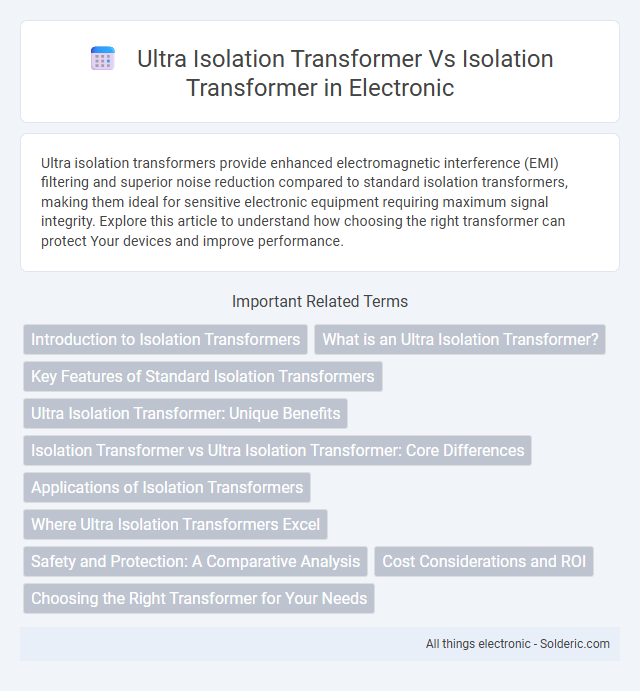Ultra isolation transformers provide enhanced electromagnetic interference (EMI) filtering and superior noise reduction compared to standard isolation transformers, making them ideal for sensitive electronic equipment requiring maximum signal integrity. Explore this article to understand how choosing the right transformer can protect Your devices and improve performance.
Comparison Table
| Feature | Ultra Isolation Transformer | Isolation Transformer |
|---|---|---|
| Primary Purpose | Advanced noise suppression and superior isolation for sensitive electronics | General electrical isolation and safety protection |
| Noise Attenuation | High attenuation of electromagnetic interference (EMI) and radio frequency interference (RFI) | Moderate noise reduction capabilities |
| Design Complexity | Multiple shielding layers and precision winding for enhanced isolation | Standard winding with basic isolation techniques |
| Application | Medical devices, precision lab equipment, audio systems requiring ultimate isolation | Industrial machinery, power tools, and general-purpose isolation |
| Cost | Higher cost due to advanced materials and construction | Lower cost, widely available |
| Isolation Voltage Rating | Typically higher voltage isolation, often 3kV and above | Standard isolation voltage, generally around 1kV to 2.5kV |
| Leakage Current | Extremely low leakage current suited for sensitive environments | Higher leakage current compared to ultra isolation transformers |
Introduction to Isolation Transformers
Isolation transformers provide electrical isolation between the input and output, enhancing safety by preventing direct electrical connection and reducing electrical noise. Ultra isolation transformers offer superior attenuation of common-mode noise and EMI, making them ideal for sensitive electronic equipment and environments with high electromagnetic interference. Both types improve power quality, but ultra isolation transformers deliver significantly higher insulation resistance and noise suppression for critical applications.
What is an Ultra Isolation Transformer?
An Ultra Isolation Transformer offers superior noise reduction and enhanced electrical isolation compared to a standard isolation transformer, targeting sensitive electronic equipment. It features advanced shielding and construction techniques to minimize electromagnetic interference (EMI) and radio-frequency interference (RFI). This transformer is ideal for environments requiring ultra-low noise and stable power supply, such as medical devices, high-end audio systems, and precision instrumentation.
Key Features of Standard Isolation Transformers
Standard isolation transformers provide crucial electrical isolation and noise reduction, protecting equipment from voltage spikes and electrical interference. Their key features include galvanic isolation, which prevents direct current flow between circuits, and reliable voltage transformation to maintain stable output levels. You benefit from improved safety and enhanced performance in sensitive electronics using these transformers.
Ultra Isolation Transformer: Unique Benefits
Ultra isolation transformers provide superior noise reduction and enhanced electrical isolation compared to standard isolation transformers, making them ideal for sensitive electronics and medical equipment. Their dual-layer shielding and advanced core materials minimize electromagnetic interference (EMI) and radio frequency interference (RFI), ensuring cleaner power delivery. Investing in an ultra isolation transformer protects your devices from electrical disturbances, improving performance and longevity.
Isolation Transformer vs Ultra Isolation Transformer: Core Differences
Isolation transformers provide basic electrical isolation by separating the input and output circuits to reduce noise and enhance safety. Ultra isolation transformers offer superior noise suppression with advanced magnetic shielding and winding techniques, delivering ultra-low leakage inductance and higher common-mode noise attenuation. Your choice depends on the required level of electromagnetic interference reduction and application sensitivity.
Applications of Isolation Transformers
Isolation transformers are widely used in sensitive electronic equipment to reduce noise and ensure electrical safety by separating the device from the power source. Ultra isolation transformers provide enhanced electromagnetic interference (EMI) suppression and superior noise attenuation, making them ideal for medical devices, precision instruments, and audio equipment in critical environments. Both types safeguard against electrical surges and ground loops, but ultra isolation transformers excel in environments demanding minimal electrical noise and high reliability.
Where Ultra Isolation Transformers Excel
Ultra isolation transformers excel in applications requiring superior noise reduction and enhanced electromagnetic interference (EMI) suppression, making them ideal for sensitive medical equipment, precision measuring instruments, and high-fidelity audio systems. Their enhanced winding and core designs provide exceptional common-mode noise attenuation and improved isolation compared to standard isolation transformers. You benefit from ultra isolation transformers when precise signal integrity and maximum equipment protection are critical in your electrical setups.
Safety and Protection: A Comparative Analysis
Ultra isolation transformers provide enhanced safety and protection by significantly reducing electromagnetic interference (EMI) and offering superior noise suppression compared to standard isolation transformers. Your sensitive electronic equipment benefits from ultra isolation transformers' advanced shielding and higher insulation resistance, minimizing the risk of electrical shocks and transient voltage spikes. This elevated level of protection ensures more reliable performance in critical applications such as medical devices and industrial control systems.
Cost Considerations and ROI
Ultra isolation transformers generally have a higher upfront cost due to enhanced materials and advanced design features that provide superior noise reduction and isolation performance. While the initial investment is significant, the improved reliability and reduced downtime can lead to a faster return on investment (ROI) in critical applications like medical equipment and sensitive industrial processes. Standard isolation transformers offer lower initial costs but may result in higher long-term expenses from maintenance and potential equipment failure caused by less effective isolation.
Choosing the Right Transformer for Your Needs
Ultra isolation transformers provide superior noise reduction and enhanced electromagnetic interference (EMI) filtering compared to standard isolation transformers, making them ideal for sensitive electronic equipment and audio applications. Your choice depends on the level of signal purity and noise suppression required; ultra isolation transformers excel in environments demanding high-fidelity power and minimal interference. Selecting the right transformer ensures optimal protection and performance for your specific electrical and electronic systems.
ultra isolation transformer vs isolation transformer Infographic

 solderic.com
solderic.com